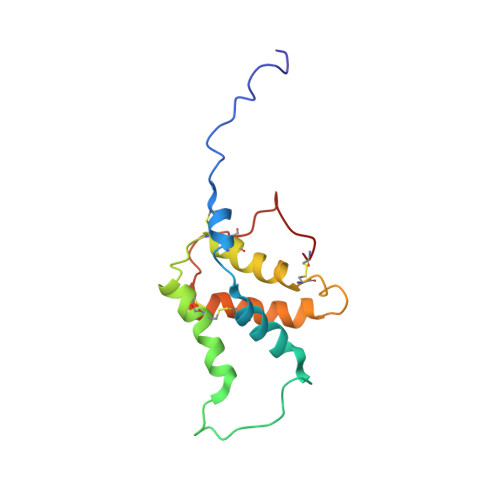Structure and Stability of 2S Albumin-Type Peanut Allergens: Implications for the Severity of Peanut Allergic Reactions.
Lehmann, K., Schweimer, K., Reese, G., Randow, S., Suhr, M., Becker, W., Vieths, S., Roesch, P.(2006) Biochem J 395: 463
- PubMed: 16372900
- DOI: https://doi.org/10.1042/BJ20051728
- Primary Citation of Related Structures:
1W2Q - PubMed Abstract:
Resistance to proteolytic enzymes and heat is thought to be a prerequisite property of food allergens. Allergens from peanut (Arachis hypogaea) are the most frequent cause of fatal food allergic reactions. The allergenic 2S albumin Ara h 2 and the homologous minor allergen Ara h 6 were studied at the molecular level with regard to allergenic potency of native and protease-treated allergen. A high-resolution solution structure of the protease-resistant core of Ara h 6 was determined by NMR spectroscopy, and homology modelling was applied to generate an Ara h 2 structure. Ara h 2 appeared to be the more potent allergen, even though the two peanut allergens share substantial cross-reactivity. Both allergens contain cores that are highly resistant to proteolytic digestion and to temperatures of up to 100 degrees C. Even though IgE antibody-binding capacity was reduced by protease treatment, the mediator release from a functional equivalent of a mast cell or basophil, the humanized RBL (rat basophilic leukaemia) cell, demonstrated that this reduction in IgE antibody-binding capacity does not necessarily translate into reduced allergenic potency. Native Ara h 2 and Ara h 6 have virtually identical allergenic potency as compared with the allergens that were treated with digestive enzymes. The folds of the allergenic cores are virtually identical with each other and with the fold of the corresponding regions in the undigested proteins. The extreme immunological stability of the core structures of Ara h 2 and Ara h 6 provides an explanation for the persistence of the allergenic potency even after food processing.
Organizational Affiliation:
Lehrstuhl Biopolymere, Universität Bayreuth, 95440 Bayreuth, Germany.














